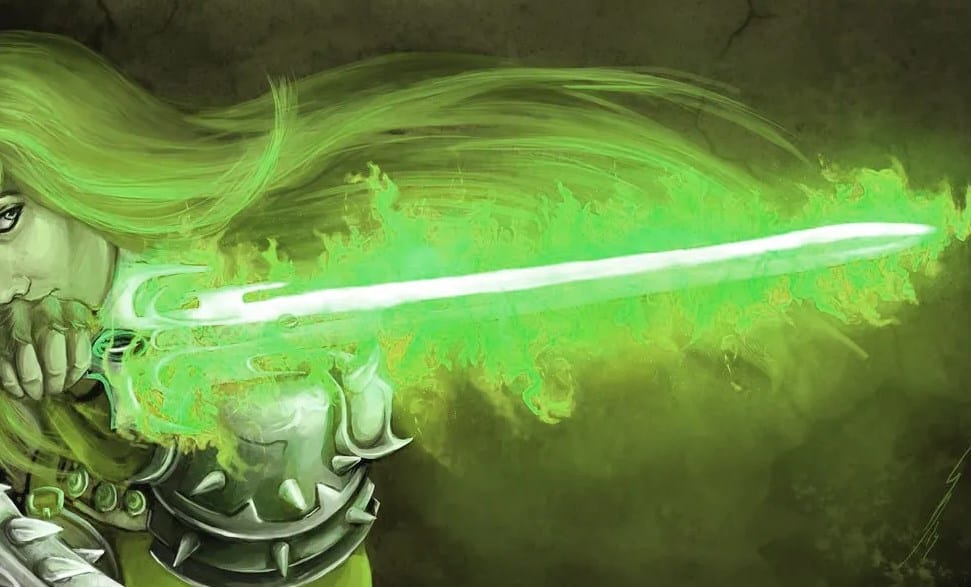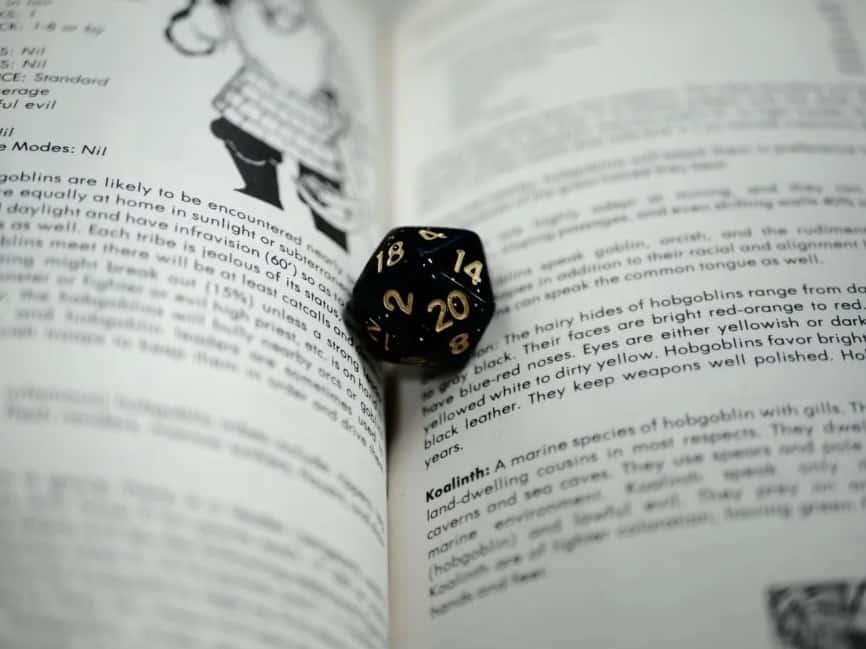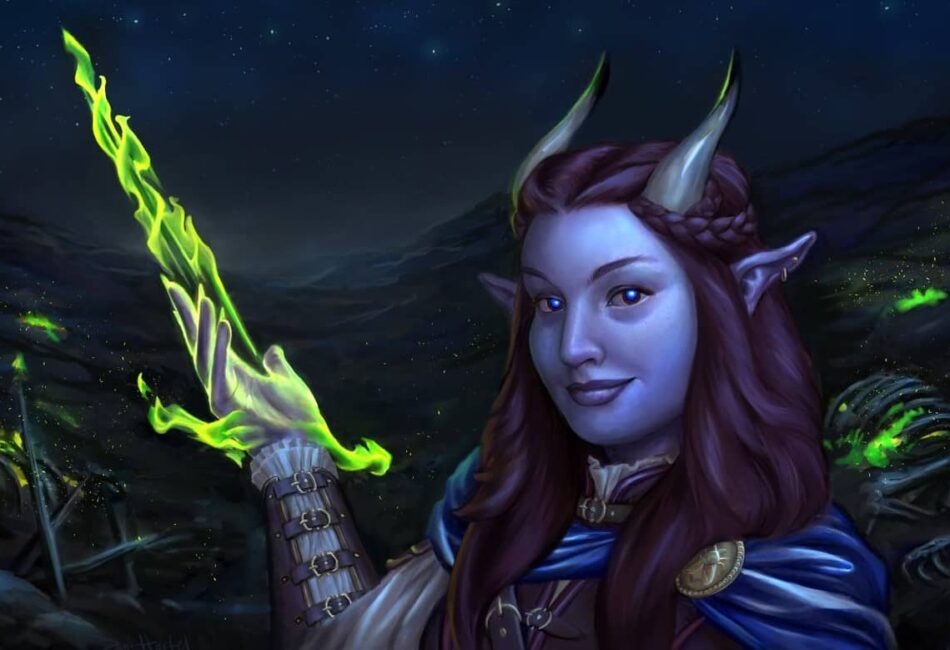Spellcasting is one of those things in a D&D Game that is typically done by the squishy Wizard. Even Druids with their wooden or stone armor just aren’t as protected as their steel-clad counterparts. But there are occasions where the front line fails to hold enemies back, or the monsters are smart and know how to target the robed figures throwing fireball spells at them.
When that happens and your very melee vulnerable spell casters are found in melee, then things might turn bad unless they have some way of fighting back. While some mages have D&D spells to help them disorient, evade, or defend themselves against attackers, wouldn’t it be great if a wizard could do some close combat damage?
With the spell “Green Flame Blade” they can fight back in melee, but how does this spell work? Why would you use it? And should you throw your Wizard on the enemy’s sword to use it effectively? Here’s our thorough Green Flame Blade 5e Guide.
What is the Green Flame Blade?
The green flame blade, according to both Tasha’s Caldron of Everything and The Sword Coast Adventurers is a cantrip and has these stats:
- Evocation cantrip
- Casting Time: 1 action
- Range: Self (5-foot radius)
- Components: S, M (a melee weapon worth at least 1 sp)
- Classes: Warlock, Wizard, Sorcerer
- Duration: Instantaneous
You brandish the weapon used in the spell’s casting and make a melee attack with it against one creature within 5 feet of you. On a hit, the target suffers the weapon attack’s normal effects, and you can cause green fire to leap from the target to a different creature of your choice that you can see within 5 feet of it. The second creature takes fire damage equal to your spellcasting ability modifier.
At Higher Levels. At the 5th level, the melee attack deals an extra 1d8 fire damage to the target on a hit, and the fire damage to the second creature increases to 1d8 + your spellcasting ability modifier. Both damage rolls increase by 1d8 at the 11th level (2d8 and 2d8) and the 17th level (3d8 and 3d8).
First, let’s break down the fact that it is a cantrip, where your spellcaster can cast the spell as many times as they want, as long as they have a melee weapon. It has a 5-foot radius so you can only use the spell on those right next to you, and you need a somatic component and a melee weapon worth at least one silver piece.
That means that you can’t use a random stick as a weapon, but most of the weapons you can use and buy in the game are much more than one silver piece.
On a hit, you resolve the attack roll and damage normally, but also, a stream of green fire spits out from the weapon and slams into another nearby target if you need it. That extra fire damage is equal to your spellcasting modifier.
At the 5th level, the target takes 1d8 fire damage, and the enemy that you make the fire attack against suffers an extra 1d8 fire damage. Then the damage goes up for both attacks by 1d8 at the 11th and the 17 levels.
When Should You Use Green Flame Blade?

Most wizards and warlocks shouldn’t be delving into melee combat unless you are multiclassing or building a spell sword type of class. Still, if you find yourself getting overwhelmed by melee weapons and melee attackers, you can charge into combat with your own weapon.
Granted, a green flame blade shouldn’t be your go-to cantrip because there are a few problems with it, but we will get to that later. Plus, there are some other good cantrips out there like Elderich Blast and Fire Bolt for casters that allow them to do some serious damage but also stay out of melee range.
Plus, it really doesn’t do a ton of damage to the target at a low level. First, you need to hit the target which most wizards and warlocks are not going to do in melee unless they take special perks. Strong druids might have the Shillelagh which allows them to make attacks with their spellcasting ability rather than their strength, which can allow them to strike at nearby enemies with their club or staff.
Still, you hit the target with the melee weapon’s attack damage, and then the fire leaps out at a creature that is 5 feet from the attacked creature. This might be good for if you have two enemies within melee range or within 5 feet of one another, but the damage is only great at low levels and having two enemies near you at low levels isn’t the best.
Should I Use a Strength or Finesse Weapon?
Of course, weapons that use the strength of the wielder are good, but there are also finesse weapons such as rapiers and daggers, and if you are a caster with pretty good dexterity, you can use it. You can even use sneak attack damage if you use the spell and meet the requirements for a sneak attack.
Who Gets The Spell?
The Wizard, Sorcerer, and the Warlock can all take this spell at level one without burning a feat on it. However, any class from a barbarian to a rogue can use this spell if they select the Magic Initiate Feat. This feat states that, according to the Player’s Handbook, “Choose a class: bard, cleric, druid, sorcerer, warlock, or wizard. You learn two cantrips of your choice from that class’s spell list. In addition, choose one 1st-level spell to learn from that same list. Using this feat, you can cast the spell once at its lowest level, and you must finish a long rest before you can cast it in this way again.
Your spellcasting ability for these spells depends on the class you chose: Charisma for bard, sorcerer, or warlock; Wisdom for cleric or druid; or Intelligence for a wizard.”
Spell Sniper also allows you to pick a cantrip that requires an attack roll if you can already cast at least one spell. So you will learn the cantrip from the same list as the Magic initiate and will have the same spellcasting ability depending on the class you chose.
So if you burn this feat and pick from the Sorcerer, Wizard, or Warlock cantrip trees, you can pick from Green Flame Blade and even Booming Blade, which can be a pretty good combo if you play it right.
Combining It With Booming Blade

One of the things that some players like to do is use the spell Booming Blade with the Green Flame Blade. Here are the stats for Booming Blade so you can compare them.
- Evocation cantrip
- Casting Time: 1 action
- Range: Self (5-foot radius)
- Components: S, M (a melee weapon worth at least 1 sp)
- Duration: 1 round
You brandish the weapon used in the spell’s casting and make a melee attack with it against one creature within 5 feet of you. On a hit, the target suffers the weapon attack’s normal effects and then becomes sheathed in booming energy until the start of your next turn. If the target willingly moves 5 feet or more before then, the target takes 1d8 thunder damage, and the spell ends.
At Higher Levels. At the 5th level, the melee attack deals an extra 1d8 thunder damage to the target on a hit, and the damage the target takes for moving increases to 2d8. Both damage rolls increase by 1d8 at the 11th level (2d8 and 3d8) and again at the 17th level (3d8 and 4d8).
Much like the Green Flame Blade, you can use the Booming Blade to make an attack. If it hits, the target takes the regular damage from the melee attack and also sheathes them in booming energy. If they move even 5 feet away from you they take 1d8 thunder damage.
At higher levels, the 1d8 thunder damage goes up, and the extra damage from the thunder from the melee attack goes up. It’s good to have both blade cantrips available if you find yourself in situations where they are needed, especially if you are locked in melee and can’t rely on others to save you.
Make The Enemy Move

Of course, you might ask; why would the enemy move if it knows it would take all the extra thunder damage? Well, in that case you will need to make it move. Having party members who can cast ‘Lightning Lure’ ‘Repelling Blast’ ‘Moon beam’ or other attacks that can help to control the battlefield and how characters move upon it can be very interesting.
Green Flame Blade FAQ
Question: How Do You Roleplay Green Flame Blade?
Answer: Now, while casters enchanting their blade with magical fire can be easily explained as they have the ability to do that if you have the character’s taking feats that allow them to use this ability, you will need to roleplay a bit. If your players are the type of people who like to RP and get to where they have a story for everything they do, here are some ideas:
First, maybe it’s not the player casting the fire on their weapon, but it is rather the weapon itself drawing power from inside the character to lash out with flame. You could give their weapon a story, say that the character has unlocked some hidden power and they need to see where it came from, or maybe you take the cantrip away from the player.
Roll some dice and have the effect trigger randomly during combat, giving an extra layer of mystery to both the spell and the weapon. Your players’ will be hunting for the story or possibly creating their own around the weapon, which is always fun and takes the pressure off for you as a DM. Then you can let your players build the story for a change, which is a lot of fun!
Question: Does It Have To Be A Blade?
Answer: Well, the rules for the spell state that you need a weapon that costs 1 silver piece (sp) or more, which basically only rules out homemade weapons or random debris your characters have picked up. You can have a Green Flame Dagger, Green Flame Axe, Green Flame Flail, or any other melee weapon your spellcaster might have a reason to carry. Maybe they are using a weapon in the service of their gods or because of their backstory.
As long as it is worth at least 1 sp, which most weapons are, you will be fine. The same restriction goes with booming blades as well. Make sure to customize your weapons if you want and make it all true to your character because it is going to make the gameplay that much more interesting.
Question: Does It Need To Be Green?
Answer: Since the Green Flame Blade is a cosmetic burst of energy for your weapon, it can be any color you wish it to be. Maybe your character has a special attachment to the color blue or gold or orange! Talk to your DM and nine times out of ten they will allow you to change your color.
There are actually two reasons why the magical flame was green. The first was that the Acquisitions incorporated was folded into D&D, and Chris Perkins ran a podcast where players shouted the words ‘Green Flame’ whenever he described the green fire, and the community kept it all going.
The second reason is that in the same game, the green fire was a signal to the players that the flame, the torches that held it, the area around the fire, or something else was magical and the players’ needed to investigate. After all, would you walk past an area with regular fires burning? Or would you stop and inspect a green fire? Most players need to have neon signs pointing the way to anything interesting, so the green fire is a lore friendly way to support that.
- DnD Demons Guide: What Are Demons in 5e? - September 18, 2021
- Detect Thoughts 5e Guide: When, Why and How to Use It - September 9, 2021
- The Ultimate DnD Toll the Dead 5e Guide - September 9, 2021

